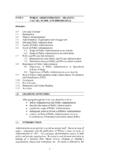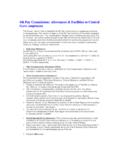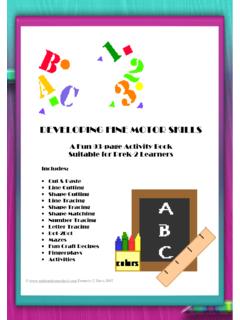Transcription of Controversy in education: Inclusion vs. Self-contained ...
1 Controversy in education: Inclusion vs. Self-contained classrooms Jennifer Decatur Professor Bassett April 22, 2007 Nature of Schools ED 5 Inclusion vs. Self-contained classrooms One issue in education today is whether or not students with special needs should be taught through Inclusion or be kept in a Self-contained classroom. Both of these methods of education provide advantages and disadvantages to children with special needs. Inclusion eliminates the idea of there being special education and regular education in a school. All children disabled and non-disabled are grouped together in a classroom to learn. Clearly, the goal of all educators is to provide each and every student with the appropriate education that he or she deserves. Providing each child with an appropriate education does not mean every child should be forced to learn in a way that does not conform to his or her strengths.
2 Teachers varying in experience and expertise have differing views as to which way of educating students with disabilities is more effective. In this paper, I will discuss Inclusion , Self-contained classrooms, and their strengths and weaknesses. Arguments from both sides of this Controversy will be addressed, each provided with sufficient evidence. I will conclude this paper by presenting the reader with my opinion based on my research and experience in the field of special education. In 1975, the Individuals with Disabilities Education Act (IDEA), federal law declared that children with disabilities have the right to education in a least restrictive environment (Villa & Thousand pg 19). Inclusion provides students with special needs the chance to learn and interact with their non-disabled peers.
3 It is a trend that evolved in the late 1980s and early 1990s, basically supporting that general education is the best choice for all learners. According to, Daniel Hallahan and James Kauffman, a least restrictive environment is a legal term referring to the fact that exceptional children must be educated in as normal an environment as possible (Hallahan & Kauffman, 44). Inclusion is usually considered the least restrictive environment for students with disabilities. In some cases however, Inclusion is not always the least restrictive environment. It can be overwhelming in some cases and cause students with special needs to shut-down rather than motivate them because they are with their non-disabled peers. Full Inclusion happens when all students with disabilities are placed in their neighborhood schools in general education classrooms for the entire day.
4 My school does not operate with full Inclusion but we do send our students from the Self-contained room to some Inclusion classes throughout the day. From following and working with my students in the Inclusion classroom subjects of science and social studies I see positive sides and negative sides to Inclusion . On the positive side these students are able to, at times, work in groups with other peers that are non-disabled. However, other times the students from my group tend to exclude themselves from working with others and will ask me to either work with them in a cluster in the room or, when extremely overwhelmed by the assignment, ask if we can go back to our room as they call it. Although these students in some cases are more popular than others they still see themselves as different and in the Inclusion classroom situation do not always want to interact with their peers.
5 One plus I have seen especially throughout this year, happened with our eighth grade group. I consider this group of five students to be our most dependent. This was the group that at this time last year when asked to write an essay had to copy down word for word what to say because they couldn t pick out the information from the text book on their own and then change it into their own words. This year while practicing for the eighth grade New York State Social Studies exams known as Document Based Questions they have made excellent progress in working independently with minimal guidance. The students are presented with seven documents in which they answer two short questions for each. They are then asked to write a well-developed essay based on these documents and their knowledge of social studies.
6 Through working with these documents in the social studies class rather than going back to our room , these students worked their way through struggling with writing a few simple observations to being able to think out their own essays. Instead of being told I don t know what to write , I get asked does this sound good? In this case I see the benefits of Inclusion . Some arguments in favor of full Inclusion are that labeling people is harmful, separate education has been ineffective , people with disabilities should be seen as a minority group and ethics are more important than empirical evidence (Kauffman & Hallahan pg 45). Labeling can be very harmful because students are each individuals not a group you can give a name to. It is easiest to find labeling in schools with special needs students.
7 Occasionally I will hear the students refer to my kids saying, Well, Miss Decatur s kids get extra time to work on things . We discourage any labeling such as that in our room. When people come in they are told it is Mrs. G s room, not the special education room, not the resource room just Mrs. G s room. This however, hasn t necessarily ended all labeling. Separate education in some cases has been ineffective , mostly observed in the pull-out programs. Some special educators have found that there is usually little or no improvement in cognitive or social areas from pull-out programs, in which the students are removed from the classroom to work on skills needed for the classroom. Activists try to fight against the oppression of people with disabilities; they see these people as a minority group.
8 When looking at ethics, full- Inclusion programs discriminate actually against those with disabilities. There are many arguments against Inclusion . Special and general educators along with parents are satisfied with alternative placements such as pull-out programs and Self-contained rooms. Many times general educators are not willing, or simply untrained to properly educate students with special needs. Many teachers and parents feel that Inclusion is not right in many cases for students. In some ways it helps lead to them being excluded more than anything. Some teachers have worked for many years with a degree in elementary education or adolescent education but did not receive the background in special education they needed to work with special needs students in the Inclusion classroom.
9 These teachers are now working in classrooms with students who have special needs each day. In some situations the teachers work hard to include those with special needs in simple class participation and activities. Other teachers simply have the students in the room and continue with the teaching strategies they have always used, which in some cases do not work for the now included students. Special educators feel that alternative placements are a must because evidence does not show that full- Inclusion is always successful. On the opposite side of Inclusion , we have the Self-contained classroom. Some educators frown upon the Self-contained classroom because of the way students in these rooms are usually labeled. They become those people that join the class for specials and maybe lunch.
10 They don t become part of the group. Although this is a time in which the Self-contained classroom is not favored highly, it does have its benefits. In the Self-contained classroom students get services that Inclusion cannot always provide them with properly. Special education teachers can work closely with other service providers such as speech or occupational therapists to insure that the students get the most out of their services. The intensive nature of the Self-contained classroom allows for Individualized Education Programs (IEPS) to be better implemented than in some Inclusion settings. An example of this may be that in a Self-contained classroom, a student may need a teacher to read the student directions on a work sheet and show an example or two whereas in the Inclusion classroom time does not always allow for this.













